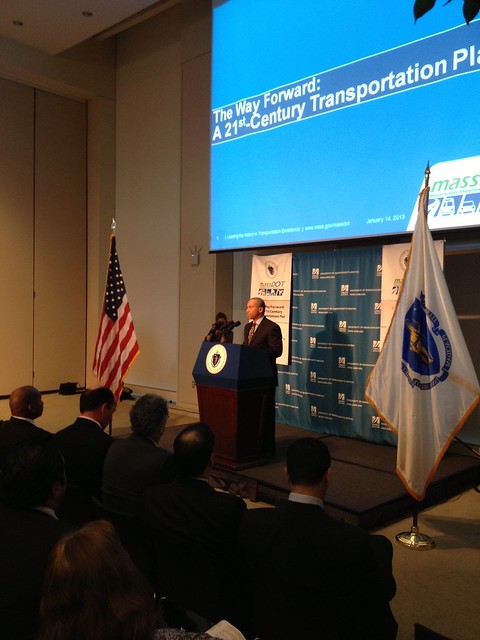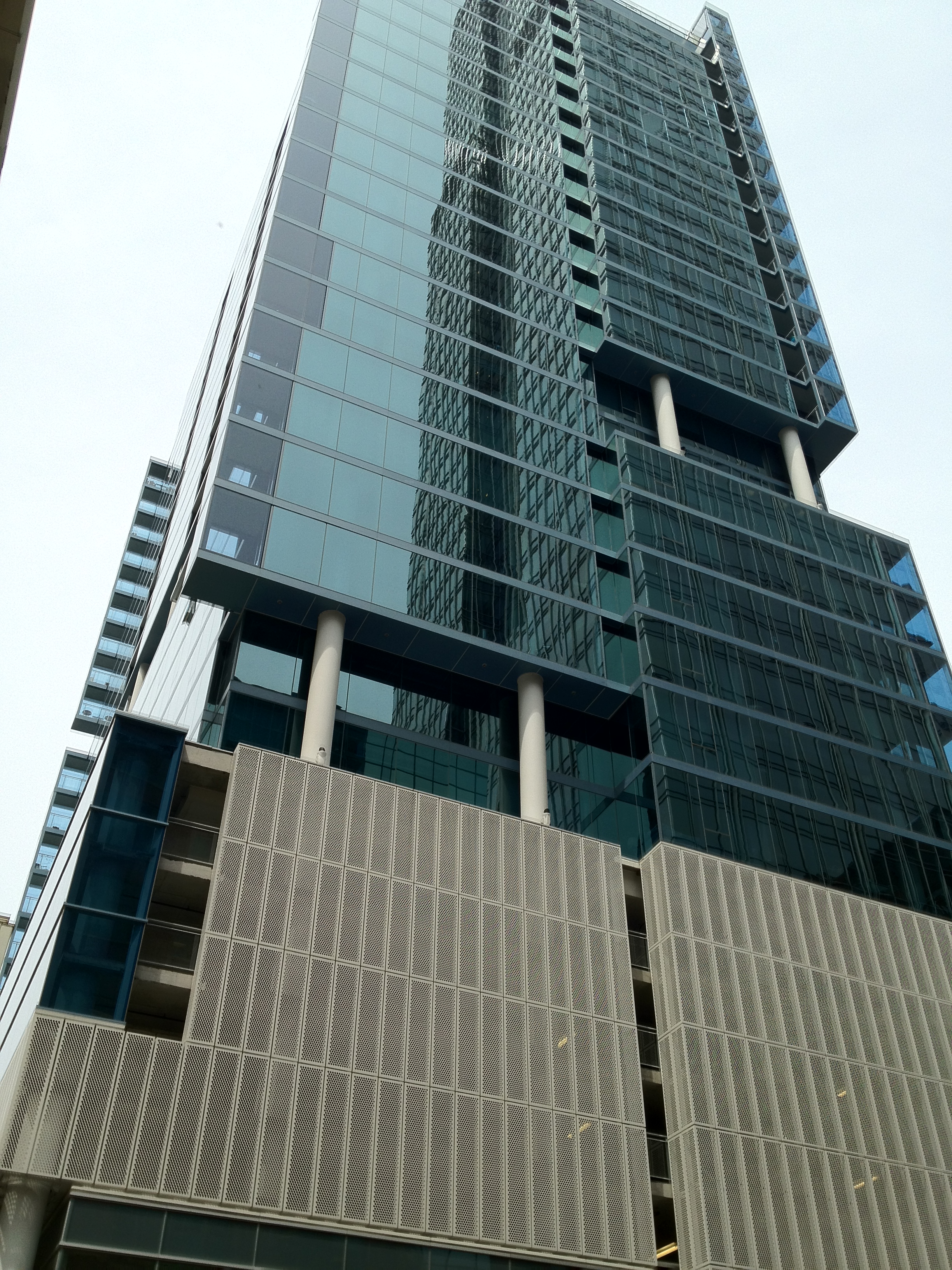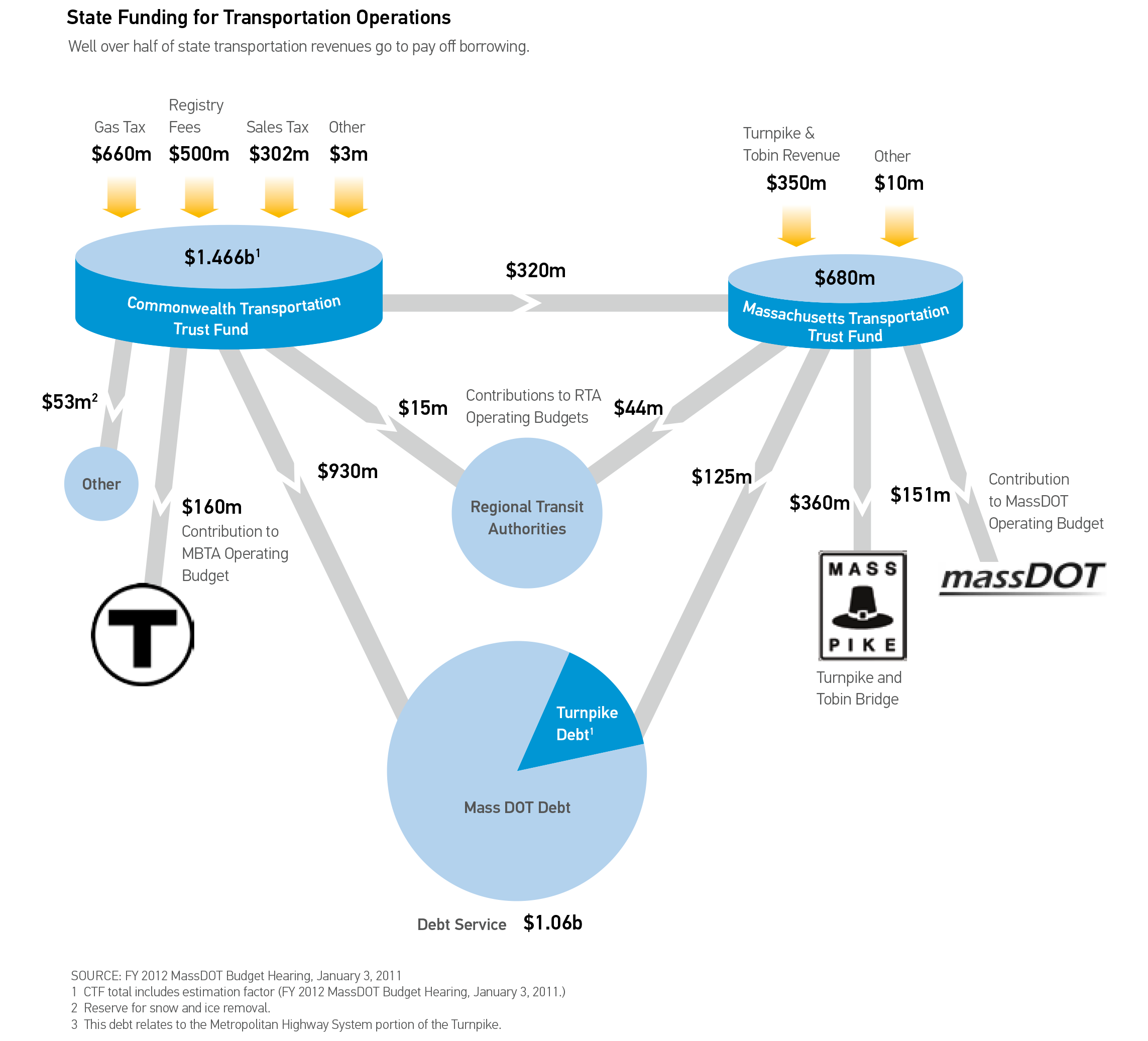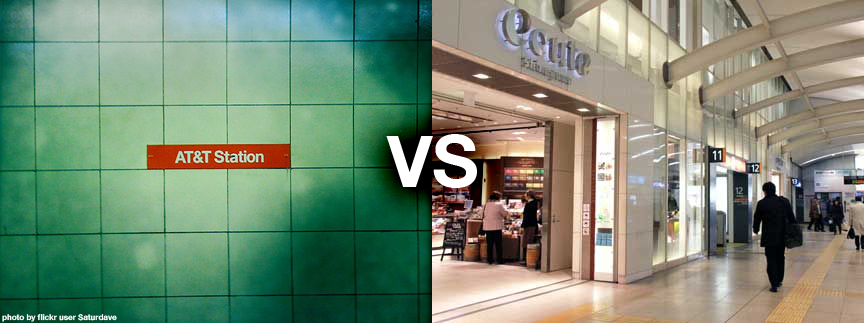
Get a Backbone! Cut the Bulls**t Off-Street Parking
 Boston has a strange way of committing to walkability, transit accessibility, and the adjustment of cultural expectations for parking per Menino's claim that 'the car is no longer king in Boston'. A large number of transit-oriented developments in and around Boston come with a lot of parking and even more is about to be built at a development that could've easily done without it.
Boston has a strange way of committing to walkability, transit accessibility, and the adjustment of cultural expectations for parking per Menino's claim that 'the car is no longer king in Boston'. A large number of transit-oriented developments in and around Boston come with a lot of parking and even more is about to be built at a development that could've easily done without it.
When news about a parking-free development in Allston started making the rounds in January, many in the neighbourhood vehemently argued against the development with the fear of increased parking pressures that we've come to expect of public comment in Boston.
Saying that the building won't have any parking is very disingenuous. The project was originally submitted to the Boston Redevelopment Authority[PDF] with the plan to have six parking spaces for car sharing services (e.g. Zipcar or Hertz Connect). Instead, the development was approved with 35 parking spaces.
Paul McMorrow nails the issue right on the head in his Globe editorial:
Nearly every developer who has ever tried to build in Boston has run into neighborhood interference over parking. Bostonians will shiv anyone who threatens to dilute the supply of free on-street parking. It’s the city’s job to calm these fears, and strike a balance between neighbors and developers, who cover the astronomical costs of building off-street parking by collecting inflated rents. This balancing act shouldn’t be as delicate as it once was, since city-dwellers are now far less married to their cars. But it’s still up to the city to make parking regulations catch up to the market.
[Sebastian] Mariscal’s Allston development isn’t overreaching at all by zeroing out cars entirely. It’s in a part of town that will undergo a dramatic transformation over the next decade, thanks to New Balance’s New Brighton Landing development. Mariscal’s building site is three blocks from a planned commuter rail stop. It’s a 10-minute walk from the Green Line. These are hardly insurmountable distances. And the market for car-free housing is far greater than Mariscal’s doubters believe. More than half of Boston residents currently take the T, bike, or walk to work. There are now 27,000 more car-free workers living in the city than there were a decade ago. Gathering 44 of them in one building should be a layup. Getting the city’s blessing to do so should have been, too.
The concerns about increased parking pressures were, as usual, not quantified or contested despite the fact that our apartment-dwelling urbanites are re-learning how to share, car sharing significantly reduces car ownership or the potential to own a car, and a shit ton of parking will be dumped on the area when New Balance's New Brighton Landing is finished. Add to that the state's commitment to a new commuter rail stop to…mitigate the need for parking? Wait, what’s going on here?
As noted in New Balance's submitted project documents, there's already a 1,200 space parking garage for the existing development and all new parking will be provided on-site. So a new commuter rail station is being put in, but we're still anticipating a need for larger amounts of parking?
The BRA's own vision for the area is inspiring and talks about developing a walkable, transit-oriented neighbourhood, but their recommendations for transportation improvements talk more from the perspective of improving car throughput and access to the Mass Pike and leave transit improvements to the hopeful increase of bus service and eventual arrival of a commuter rail station.
Parking and the availability of it in future developments further dramatically affects transit use and the effectiveness of transit, even with increased frequency of service, despite promising to increase the area's 'traffic' throughput. In fact, it's the sheer volume of car traffic that already chokes the existing roads and, in turn, transit service. More parking will only serve to give more people the option to drive.
The area's debilitating automobile traffic is a major reason why the 57 and 57A are late at least 35% of the time, which likely is disproportionately felt by the majority of riders who use the bus during rush hours. The 64, which directly serves the New Balance site and runs past Mariscal's 37 North Beacon St, is late almost 40% of the time.
This isn't to say service can't be improved in spite of additional parking, but no plans have been revealed so far to include dedicated bus lanes or other forms of transit prioritization to improve the reliability of the existing bus service. Without it, the area will remain auto-dependent and people will continue opting to drive and sit in traffic rather than wait for late and crowded buses.
And it's not just in Allston...
Similar visions of parking-loaded 'transit-oriented' developments have been approved immediately next to the new Yawkey Station that will also see increased commuter rail service and adjacent the new Assembly Square station on the Orange Line. The Assembly Row development in Somerville was approved with 10,066 spaces[PDF] while the Fenway Center development at Yawkey will see a more reasonable 1,290 spaces. Millennium Tower at Downtown Crossing, within walking distance of every transit line and commuter rail line in Western Massachusetts, has even been approved with 550 spaces despite thousands of public parking spaces in the neighbourhood that empty out after business hours, 822 of which sit in my office building across the street.
Fenway Center's numbers are still disproportionate to the need of the area considering its transit accessibility that will only increase over time and the further parking volume promised from other new and approved developments. The perception seems to be that Fenway games need more parking despite the fixed number of seats in the ballpark and the new two-platform commuter rail stop that will see full-time service once complete. Exacerbating neighbourhood traffic by making it more convenient to people to drive to ball games and the growing number of posh restaurants in Fenway isn't a great way to convince those very neighbourhoods that development is good.
These are all examples of transit-related capital investments being made by the state, MassDOT/MBTA, being undermined by the BRA approving adjacent 'transit-oriented' developments with large volumes of parking. While in some of these projects, the parking can and probably will be converted to other uses if/when the spaces go underutilized, but that alone is an expensive venture and the inclusion of parking into the development already increases its base cost. This increased cost translates into less housing and higher rents for those fewer units that get built.
But it can get better...
While there's not much that can be done to reduce the volume of parking at these already approved developments, the BRA, Boston Transportation Department, and MBTA can do a much better job of talking to each other in future developments about the real generator of automobile traffic: parking.
Instead of imposing parking 'guidelines', which act more as legal parking minimums, the BRA could offer 'parking credits' for developers to apportion parking off-site in existing parking structures. This would encourage more developers to build less expensive housing that would more effectively address Boston's severe housing crunch.
Additionally, the new developments don't necessarily need 1:1 or even 1:2 parking ratios because of a significant latent demand for housing without parking and the ability to address travel needs by improving the reliability of transit. Parking 'needs' can and will be further driven down by increasing the number of amenities and affordable, modern office spaces in the area, practically inherent in the act of increasing density with new development.
What else can we do with less expensive developments? Well, we can encourage developers to include modern civic and municipal spaces into new buildings. The city can even create new revenue with forward-thinking land use deals instead of selling the property outright for a one-time cash infusion. This further adds to the number of amenities within walking distance to new and existing developments and increases the livability and value of our neighbourhoods.
Again, it all comes down to our transportation choices when we have the opportunities to remake our cities block-by-block. 'When I design a building, the first thing I have to resolve is my parking,' Mariscal notes, just as every other developer before him and any to follow. By beefing up transit and actually treating it like the lifeblood of our city, we can reduce the pressure on developers to design parking into their buildings and the cost of our rent. In time, Bostonians will learn put down their shivs and not have a conniption over each development proposed without or with little parking when there's transit nearby just waiting to be improved. The BRA isn't helping by not doing its due diligence and addressing resident concerns with reason.
Has MassDOT Reached the End of the Road for Internal Reform?
 Two Fridays ago, Governor Deval Patrick stated that he would unveil a proposal later this month to raise the necessary money through taxes or fees to fix the financially beleaguered transport network. Today, the details of where the money would be coming from and how much were revealed by the Governor and MassDOT.
Two Fridays ago, Governor Deval Patrick stated that he would unveil a proposal later this month to raise the necessary money through taxes or fees to fix the financially beleaguered transport network. Today, the details of where the money would be coming from and how much were revealed by the Governor and MassDOT.
The original Globe article on the issue highlighted that the annual gap between actual needs and what is actually raised and spent amounts to nearly $1 billion annually. This comes even after many years of reform that have consolidated a number of state agencies under MassDOT and produced efficiencies that have saved the state countless hundreds of millions of dollars over the years.
As temperatures dip far below freezing once again, it becomes painfully clear to many commuters that our aging transit system is in dire need of investment that no amount of structural reform will provide. MBCR spokesman Scott Farmelant notes, 'There is only one way to prevent cold-weather delays: increased capital investment into the infrastructure, in particular signals, switches, and bridges.'
Likewise, there are many transit, commuter, and even high speed rail agencies that operate in similar climates in Europe that have overcome[PDF] sub-zero temperatures. By investing in weather-resistant infrastructure that is engineered to anticipate winter conditions and maintaining a modern fleet of trains, service impacts remain low. Sometimes, even the older equipment gets pulled out to help battle snow, much less extreme cold conditions, as happened in Sweden in 2010.
That said, it's no wonder the MBTA encounters such severe weather-related issues, even without snow. No amount of consolidation or reorganisation of the MBTA or MassDOT can generate the amount of money to buy new signals, trains, or track needed to even prevent equipment-related delays on a sunny spring day. It's time to make the hard decisions and start raising new revenue or increasing the amount that comes from existing revenue sources.
New revenues in the short term can come from a new vehicle miles travelled tax, congestion pricing, and new road tolls. Unfortunately, America's road users are conditioned to object to paying for any road maintenance out of pockets and with good reason. For decades, the expectation has been that income taxes and the gas tax alone was enough to maintain the growing glut of roads we've built out:
If you actually make people pay out of pocket to get a faster trip, people aren’t willing to spend that much. We have two bridges across Lake Washington. One has to be replaced. They put a toll on it to help pay for the project, and immediately traffic plummeted. People are driving around to get to other side, driving on the other road, sitting through congestion, timing their trips differently in order to avoid tolls. People really, if they have to pay out of pocket for a quicker trip, they don’t place much value on it.
So we’re expecting taxpayers to foot the bill for things the drivers themselves will not pay for.
With that in mind, why shouldn't transit riders also be made to pay more out of pocket for transit improvements? The truth is that we, as a state and a nation, have been subsidising roads more than transit by a large margin for decades and those public investments have done little to provide effective core services. In fact, T riders pay more in fares ($451 million in 2011) to run the T than drivers pay in tolls across the Tobin Bridge and entire Turnpike ($350 million in 2011) to pay for a much larger and more expensive system.
Taking the long view, it cannot be said enough that MassDOT and the MBTA can better capitalise on their existing properties by developing on them instead of selling them outright. Selling property and air rights is one way to gain revenue but is not a viable long-term solution.
Property is the most valuable asset of any railroad and Japan's railroads have known this for years. Build homes and businesses in a walkable pattern around your stations and your network and its destinations become that much more accessible. In the long run, you have a steady stream of income from property rentals and fares from riders who depend on your system. Somerville's Assembly Square mega-project is the best example of this type of destination-creating redevelopment that is fuelled by transit. My only issue with the project is the alarming 7,500 parking spaces that will be constructed for such a walkable development adjacent a new $57 million Orange Line station.

Furthermore, building more transit-oriented development and strengthening those neighbourhoods has the potential to address the growing demand for market-priced units and outstanding need for affordable housing. The impact of new user fees on the impoverished who need to drive to work is an unfortunate reality. This can only be mitigated by providing quality, transit-accessible neighbourhoods with good access to affordable housing, jobs matched to the skills of those residents, and quality schools that provide them and their children access to upward social mobility. As more opportunities arise for people to live in areas better able to serve transit, the case for outward growth and maintenance of far-reaching transit routes declines as the case for road-based user fees increases politically.
Value capture taxes are also another way to revenue from development around stations. In addition to adding value to our existing transit system, new developments bring higher property values. Value capture capitalises on this rise in property values by enforcing fees or taxes on developers or landowners in the area of redevelopment and can go right back into maintaining the very infrastructure that serves that neighbourhood.
Ultimately, it's long-term, smart growth strategies championed by MAPC and MassDOT's mode shift initiative that will limit the amount of new infrastructure that we'll have to borrow to spend and maintain. They will also allow us to derive more value from the infrastructure we've already built and are currently paying for. New road construction cannot continue to be used as an argument for continued debt spending under the prospect of economic development when our crumbling core infrastructure is inhibiting in-place economic growth.
In the short term, there are several ways the state can improve the sorry state of affairs with transportation funding, but most involve making tough decisions about new taxes or fees. Even less can be done in the near term to reduce the need for additional spending to maintain our crumbling infrastructure.
What's In a Name? MBTA Sells Out Boston In Its Naming Rights Plan
The question is on the table again as the MBTA moves forward with its interest in selling naming rights as IMG Worldwide as been announced as the firm that will conduct a 'a thorough analysis to determine if there's a market for naming rights and what the value would be', according to Joe Pesaturo of the MBTA.
Boston is not unique in its operating budget issues, nor is it unique in some of its attempts to close the funding gap. About a year ago, Boston joined New York, Chicago, Philadelphia, Austin, Toronto, and New Jersey in the growing list of North American transit agencies trying desperately to close operating gaps with a funding concept that is an illusion and hardly effective for actually raising the revenues that agencies claim.
To bring it home, one of my followers on Twitter brought to my attention a sponsorship from 1997 to 2000 by Citizens Bank to rename State on the Blue and Orange Lines to State/Citizens Bank. The sponsorship eventually failed and the station's name was reverted.
Ben Kabak in New York has written numerous posts on the issue (in the numerous links above), so I won't bother rehashing a topic. I will however highlight one particular public-private partnership that Chicago capitalised on, which was the $4 million rehab of the North/Claybourn station, all paid for by Apple. If we're going to be selling the system to private entities, why not work with them to refurbish the system or even build out revenue-generating properties without selling the property or rights to profits (Chicago lost $11 billion from a poor leasing agreement of its parking meters to Morgan Stanley)?
While we shouldn't necessarily be relying on commercial entities to be paying for and completely refurbishing our public infrastructure just so they can use them as their own vehicles for advertising, public transport is in an ailing state. Budgets are tight and will continue to get tighter until the costs (of construction and maintenance) are reined in and publicly owned property can be made more profitable.
Of the latter, these public-private partnerships could be used to capitalise on unproductive, low revenue-generating properties owned by the state, such as station head houses, rights of way, and station platforms themselves. Looking at just Porter Square, why is the Shaw's located so far away from the public transport hub that likely brings in the majority of its business from commuters picking up their groceries on their commutes home? Why is there not a passage under Somerville Ave to connect to a basement level of CVS or another business and provide a safer crossing of the major boulevard? This is the ultimate form of not only transit-oriented development, but also leveraging MBTA property as convenient and profitable real-estate to developers. We may be far from Japan's platform-side malls and ramen shops, but it's high time the MBTA start pushing its property and really engaging with developers and private entities to serve the public more directly.
I'd rather be able to grab a fresh bowl of ramen and groceries conveniently on my commute home than ride through Apple/Copley Square or Macy's/Downtown Crossing, especially if I know that one initiative is more likely to keep the trains running, the lights on, and the buses well-maintained.
Categories
- Children (1)
- Diversions (1)
- Olympics (1)
- MAPC (2)
- Red–Blue Connector (2)
- Urban Design (3)
- Bus (4)
- Fares (4)
- Late Night Service (4)
- MBTA ROC (4)
- Silver Line (4)
- Snow (5)
- Blue Line (8)
- Emergency (8)
- Orange Line (8)
- Public Comment (8)
- Maintenance (9)
- Operations (9)
- Signage (9)
- Fare Collection (10)
- Labs (11)
- Safety (11)
- Planning (12)
- Communication (14)
- MBCR (14)
- MassDOT (14)
- Green Line (16)
- History & Culture (16)
- Red Line (18)
- MBTA Bus (21)
- Commuter Rail (24)
- Advocacy (26)
- Capital Construction (28)
- Politics (30)
- Podcast (35)
- News (38)
- Media (40)
- Funding (42)
- Statements (50)
- MBTA (57)



